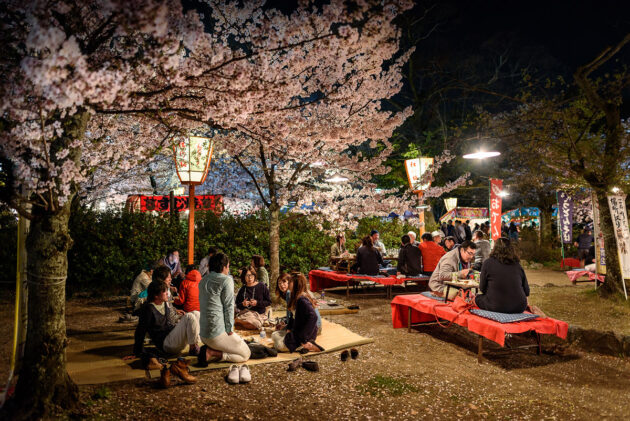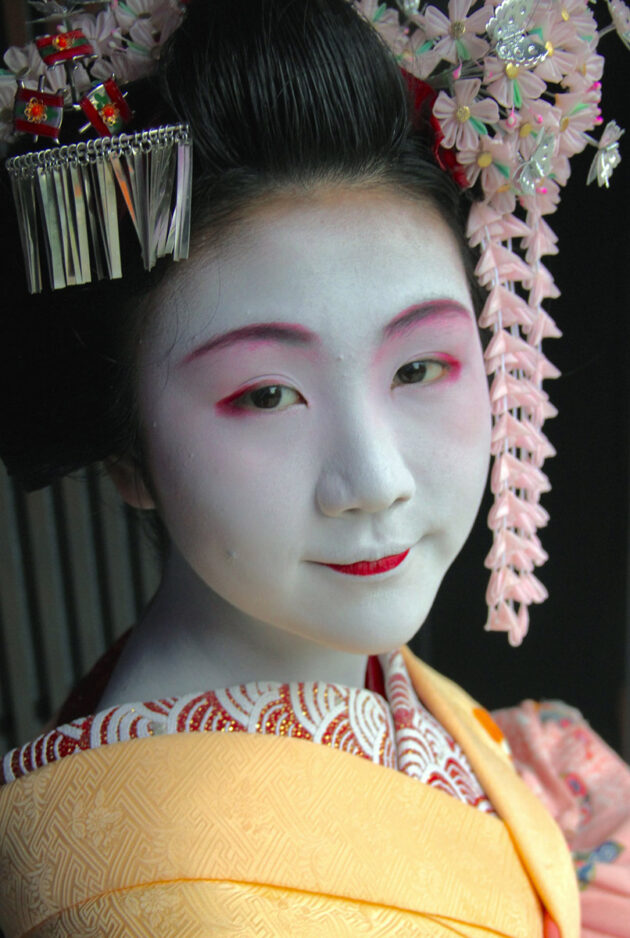¥2,300
This special print issue explores the ubiquitous role of flora as an essential subtheme in Kyoto’s timeless culture through essays, interviews, and poetry, illuminated by superb photography and artworks.

In bookstores and online, you will find no shortage of publications focusing on Kyoto’s superb gardens, or on the city’s rich heritage of tea ceremony and flower arrangement, its deeply-rooted culinary traditions based on heirloom vegetables, its longstanding literary appreciation of seasonal blossomings, or its impressive diversity of botanically-inspired decorative arts. However, each of these topics is usually presented as a separate, specialized realm. Amid this abundance, we know of no attempt, until now—in this special issue of Kyoto Journal—to explore how all these aspects reveal an essential and ubiquitous subtheme of Kyoto’s timeless culture.

The annual rite of cherry-blossom viewing is just one of myriad manifestations of seasonal changes and their celebration. Witness, for example, the maiko’s monthly almanac of exquisite hair-ornaments, and the even more detailed 72-season Japanese calendar. The very names of flowers and plants have evoked codified associations since the Heian era, and in Noh plays the spirits of plants themselves speak. Family crests draw on minute botanical differentiations in their characterizations, and tiny indoor bonsai conjure visions of the vastness of nature.
Essays, interviews, and poetry, illuminated by superb photography and artworks, printed with flawless precision by Kyoto’s highest quality printing company. A perfect Spring read—or gift.
Codi Hauka, Guest Editor
Through the multiple facets of tradition and daily life, flora is an essential part of the unique charisma of Kyoto.
Codi Hauka
Kyoto has officially recognized 234 large and important trees, nearly half of which stand in the precincts of shrines or temples. The stories of these ancient trees quietly manifest the narrative arcs and twists of Kyoto’s long and deep relationship with its natural environment.
Abe Naoko
Cherry blossoms have been part of Japanese people’s lives for more than a thousand years. When cherry trees bloom each spring, they’re a pure and long-anticipated joy, symbolising life, energy and rebirth after a long winter.
Mark Hovane
The ancient Japanese almanac of 72 micro-seasons provides a map of time that is a fascinating mixture of culture and nature. This traditional calendar marks the progress of the seasons by recording incremental changes in nature, demarcating different periods with names that reflect these seasonal changes.
Susan Pavloska
In appearance it was unlike any flower I had ever seen. A member of the iris family, it has thick, powerful leaves out of which star-like orange flowers emerge.
Miya Ando
“The Flower Atlas Calendar directs our attention to the vernacular of flowers, reminding us of the inevitable transience of each passing moment and the interconnectivity of all things.”
Stephen Mansfield
Kyoto is a phenomenal study in the different palettes of green. Some effects are accidental, others deliberate. Its intermediate tones and hues are organized in rhythmic drifts and swathes that form a continuum across open space, considerations focusing not on color per se, but on shades of green, texture, and reflectivity.
Ian Perlman
One of the great things about Kyoto used to be that a lot of the gardens were not even visible. Every machiya (row house) had a naka niwa (central courtyard garden) that was tended and treasured as much as any of the rooms.
Marc Peter Keane
The poems of the Heian period, known generally as waka (Japanese poems), almost always had as their central theme some aspect of the natural world, and those were often plants. What’s more, the plants had specific allegorical meanings that poets knew when they chose to mention them, and that readers or reciters of the poems could be expected to know as well.
Magaret Chula
The falling blossoms shift my attention downward to the display on the moss. Their arrangement looks suspiciously like the photograph on the pamphlet taken last year.
When the winter chrysanthemums go,
There’s nothing to write about
But radishes.
— Bashō
Patricia Donegan
…for a moment, we are back to a primordial time of abandonment to pleasure, of being alive in Nature’s renewal. In fact, this value of pleasure was codified in the Edo period as ukiyo-e, “the floating world” famously depicted in wood-block prints.
Chris Goto-Jones
Myōe felt that all animate and inanimate beings partook of Buddha-nature. Not only was it as though all things were one, but they really were one.
Hikaru Hirata-Miyakawa
In Buddhism, depending on who you ask, there are at least five and even up to about 13 virtues traditionally associated with the lotus.
Marc Peter Keane
On the darkly-polished floor in front of the Buddha, flowers are laid as an offering each day, a practice called sange, literally “scattered flowers.”
Cody Poulton
Within a natural setting, priest encounters plant; they exchange words, a wonder in itself; finally, through this medium of human language, they grow together in sympathy.
Tomas Svab
Bruce Hamana
…the chaji features many aspects of Kyoto flora from the food that is served, the garden and the physical structures which suggest the rusticity of mountain hermitage, to the design motifs, and literary and cultural references that suggest the wide natural world outside of the enclosed tea space.
Lewis Miesen
Nishimura Hikobei, the tenth generation family head of Zohiko, easily listed over 20 flowers that are often used as floral motifs in maki-e [lacquerware], but there are many more. While beautiful, the images can also be conceptually rich.
Peter MacIntosh
The kimono, obi, and floral hair ornaments worn by maiko and geiko change with each month, referencing the flora that mark the changing of the seasons.
Marking the festival, sprays of wisteria were formerly displayed on housefronts and hung from the roofs of oxcarts. Many other seasonal flowers are used to decorate the spectacularly colorful sunshades that the procession is also known for.
Matt Larking
A camellia cultivation boom in the early 17th century resulted in two handscrolls, One Hundred Camellias, also attributed to Kanō Sanraku . The Chinka Zufu (1688-1704; author unknown), another illustrated album, featured as many as 618 different camellia varieties.
Allan Mandell
Waking up knowing an unexpected encounter with beauty awaits… wandering the worn stone paths to Daio-in only to discover circles of botanical grace… exquisite floral designs of Shibata Zeshin float across fusuma, expertly restored by artist Fuwin Yasagawa.
Paul van der Veer
Mark Hovane
Japanese sensitivity to the life and death of flowers is evident in the word “ikebana,” deriving from “ikeru” (to make alive) and “hana” (flower). By focusing on a single flower, we are invited to symbolically recognize the life force that inhabits all things.
Izawa Masataka
Sōfū Teshigahara challenged notions that practicing Ikebana meant following established forms. His avant-garde philosophy embraced the creation of Ikebana “anytime, anywhere,” while embodying the concept that “flowers become human through Ikebana.”
Anothermountainman
…Shuho, clothed in a white ceremonial gown, began the “reborn-ikebana.” The seven steps in the process started with withering, then sprouting… a life cycle.
Sacred shimenawa-style rice-straw rope often has a cluster of rice-grains still attached, expressing a wish for another productive harvest; the symmetrical Urajiro fern, with its white underside, represents purity, longevity, and the devotion of a couple aging together…
Ken Rodgers
A vast exhibition hall is filled with vistas of micro/macro dissonance in which visitors loom like zig-zagging giants confronted by diminutive yet monumental plantings, some of which may be up to even 500 years old.
Brian Turner
As the river emerges from Mt. Sajikigatake, it winds its way into the old city, Kyoto, before passing a balcony where a cobra lily watches over it all. Lovers in a nearby room, dreaming. The moon falling towards yesterday. The river on its way toward the sea.
Robert Weis
There is similarity between writing a poem, shaping the right words and phrases while leaving a void, and creating a bonsai tree over the seasons and years, shaping the branches and creating a space between them where beauty can emerge.
Maeda Asami + Iwaza Masataka
Maeda Asami earned her Master’s in philosophy before turning to the path of pottery and more recently, creating folded origami using plant-dyed washi paper.
Bruce Hamana
The term dento no Kyoyasai (traditional produce of the capital) is restricted to cultivars grown in the Kyoto environs since before the Meiji period (1868~1912). The Kyoto Prefectural government has designated twenty-one specific vegetables as brand products of Kyoto.
John Ashburne
Humankind’s fascination with mushrooms and toadstools is ancient. The earliest reference to fungi in Japan is in the Nihongi, the book of chronicles, some 13 centuries ago.
Marc Peter Keane
In a farming village just outside of Kyoto City, on a narrow lane off to the side of the village, is a house filled with glowing glass orbs that look for all the world like some mysterious scene from a science fiction movie. These orbs, however, are not filled with alien hatchlings but with beautiful arrangements of miniature trees, rocks and moss.
Rebecca Arthur
…regardless of when I visit, I invariably find myself in the Japanese Native Plants area. This section of the Kyoto Botanical Garden covers 3.7 acres and has a collection of over 1,000 plants from across Japan.
Rachel Rasfeld
Since early 2020, I have been working on a series of mamehon (miniature books) to capture the scenery of Kyoto in watercolor and pen from live observation. Working in miniature requires me to distill the subject matter in order to maintain a cohesive composition, while still capturing just the right level of detail for each scene.
Lane Diko
Robert Brady
It must be that the fragrances of flowers touch memories far beyond our own, reach to ancient and essential depths in us that would otherwise go unmet in the onrush of our lives, and that from flowers we learn how to be deeper in both person and spirit as we live and grow the tree of humanity.